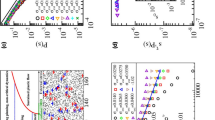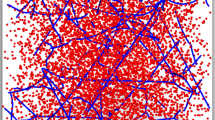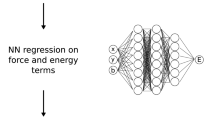Abstract
The motivation of this work was to find the appropriate molecular dynamics (MD) and slip transmission parameters of dislocation–grain boundary (GB) interaction in tantalum that correlate with the stress required for the grain boundary to deform. GBs were modeled using [\(\overline{1}\)\(\overline{1}\)2], [\(\overline{1}\)10], and [111] as rotation axes and rotation angle between 0° and 90°. Dislocation on either \(\left\{110\right\}\) or \(\left\{112\right\}\) slip planes was simulated to interact with various GB configurations. Drop in shear stress, drop in potential energy, critical distance between dislocation and GB, and critical shear stress for dislocation absorption by the GB were the parameters calculated from MD simulations of dislocation–GB interactions. Machine learning models eXtreme Gradient Boosting and SHapley Additive exPlanations (SHAP) were used to find the correlation between the various parameters and yield stress of the GB configurations. Machine learning results showed that the MD parameters—critical distance between the dislocation and GB, drop in shear stress; and slip transmission parameter—\({m}^{\prime}\) have a stronger correlation with yield stress. The SHAP results sorted the prominent slip plane and rotation axis affecting the yield stress. The configurations with dislocation on \(\left\{112\right\}\) slip plane, and configurations with [111] rotation axis were difficult to deform (higher yield stress of GB) than \(\left\{110\right\}\) slip plane and [\(\overline{1}\)\(\overline{1}\)2] and [\(\overline{1}\)10] rotation axes configurations.
Graphical abstract








Similar content being viewed by others
Explore related subjects
Discover the latest articles, news and stories from top researchers in related subjects.References
Hansen N (2004) Hall-petch relation and boundary strengthening. Scr Mater 51:801–806. https://doi.org/10.1016/j.scriptamat.2004.06.002
Patriarca L, Abuzaid W, Sehitoglu H, Maier HJ (2013) Slip transmission in bcc FeCr polycrystal. Mater Sci Eng A 588:308–317. https://doi.org/10.1016/j.msea.2013.08.050
Guo Y, Britton TB, Wilkinson AJ (2014) Slip band-grain boundary interactions in commercial-purity titanium. Acta Mater 76:1–12. https://doi.org/10.1016/j.actamat.2014.05.015
Bieler TR, Eisenlohr P, Zhang C, Phukan HJ, Crimp MA (2014) Grain boundaries and interfaces in slip transfer. Curr Opin Solid State Mater Sci 18:212–226. https://doi.org/10.1016/j.cossms.2014.05.003
Weaver JS, Li N, Mara NA, Jones DR, Cho H, Bronkhorst CA, Fensin SJ, Gray GT (2018) Slip transmission of high angle grain boundaries in body-centered cubic metals: micropillar compression of pure Ta single and bi-crystals. Acta Mater 156:356–368. https://doi.org/10.1016/j.actamat.2018.06.046
Kondo S, Mitsuma T, Shibata N, Ikuhara Y (2016) Direct observation of individual dislocation interaction processes with grain boundaries, Science. Advances 2:1–8. https://doi.org/10.1126/sciadv.1501926
Shen Z, Wagoner RH, Clark WAT (1988) Dislocation and grain boundary interactions in metals. Acta Metall 36:3231–3242. https://doi.org/10.1016/0001-6160(88)90058-2
De Koning M, Kurtz RJ, Bulatov VV, Henager CH, Hoagland RG, Cai W, Nomura M (2003) Modeling of dislocation-grain boundary interactions in FCC metals. J Nucl Mater 323:281–289. https://doi.org/10.1016/j.jnucmat.2003.08.008
Shimokawa T, Kinari T, Shintaku S (2007) Interaction mechanism between edge dislocations and asymmetrical tilt grain boundaries investigated via quasicontinuum simulations. Phys Rev B 75:1–11. https://doi.org/10.1103/PhysRevB.75.144108
Yu W, Wang Z (2012) Interactions between edge lattice dislocations and Σ11 symmetrical tilt grain boundaries in copper: a quasi-continuum method study. Acta Mater 60:5010–5021. https://doi.org/10.1016/j.actamat.2012.06.037
Wang J (2015) Atomistic simulations of dislocation pileup: grain boundaries interaction. Jom 67:1515–1525. https://doi.org/10.1007/s11837-015-1454-0
Liang Y, Yang X, Gong M, Liu G, Liu Q, Wang J (2019) Interactions between dislocations and three-dimensional annealing twins in face centered cubic metals. Comput Mater Sci 161:371–378. https://doi.org/10.1016/j.commatsci.2019.02.024
Chandra S, Samal MK, Chavan VM, Patel RJ (2015) Atomistic simulations of interaction of edge dislocation with twist grain boundaries in Al-effect of temperature and boundary misorientation. Mater Sci Eng A 646:25–32. https://doi.org/10.1016/j.msea.2015.08.049
Kacher J, Eftink BP, Cui B, Robertson IM (2014) Dislocation interactions with grain boundaries. Curr Opin Solid State Mater Sci 18:227–243. https://doi.org/10.1016/j.cossms.2014.05.004
Kacher J, Robertson IM (2014) In situ and tomographic analysis of dislocation/grain boundary interactions in titanium. Philos Mag 94:814–829. https://doi.org/10.1080/14786435.2013.868942
Hansen LT, Fullwood DT, Homer ER, Wagoner RH, Lim H, Carroll JD, Zhou G, Bong HJ (2020) An investigation of geometrically necessary dislocations and back stress in large grained tantalum via EBSD and CPFEM. Mater Sci Eng, A 772:138704. https://doi.org/10.1016/j.msea.2019.138704
Bayerschen E, McBride AT, Reddy BD, Böhlke T (2016) Review on slip transmission criteria in experiments and crystal plasticity models. J Mater Sci 51:2243–2258. https://doi.org/10.1007/s10853-015-9553-4
Ren Y, Huang Z, Wang Y, Zhou Q, Yang T, Li Q, Jia Q, Wang H (2023) Friction-induced rapid amorphization in a wear-resistant (CoCrNi)88Mo12 dual-phase medium-entropy alloy at cryogenic temperature. Compos B Eng 263:110833. https://doi.org/10.1016/j.compositesb.2023.110833
Mortazavi B, Silani M, Podryabinkin EV, Rabczuk T, Zhuang X, Shapeev AV (2021) First-principles multiscale modeling of mechanical properties in graphene/borophene heterostructures empowered by machine-learning interatomic potentials. Adv Mater. https://doi.org/10.1002/adma.202102807
Zhou Q, Luo D, Hua D, Ye W, Li S, Zou Q, Chen Z, Wang H (2022) Design and characterization of metallic glass/graphene multilayer with excellent nanowear properties. Friction 10:1913–1926. https://doi.org/10.1007/s40544-021-0581-6
Yang C, Yin C, Wu Y, Zhou Q, Liu X (2023) Atomic insights into the deformation mechanism of an amorphous wrapped nanolamellar heterostructure and its effect on self-lubrication. J Market Res 26:4206–4218. https://doi.org/10.1016/j.jmrt.2023.08.215
Talebi H, Silani M, Bordas SPA, Kerfriden P, Rabczuk T (2014) A computational library for multiscale modeling of material failure. Comput Mech 53:1047–1071. https://doi.org/10.1007/s00466-013-0948-2
Spearot DE, Sangid MD (2014) Insights on slip transmission at grain boundaries from atomistic simulations. Curr Opin Solid State Mater Sci 18:188–195. https://doi.org/10.1016/j.cossms.2014.04.001
Tsuru T, Shibutani Y, Hirouchi T (2016) A predictive model for transferability of plastic deformation through grain boundaries. AIP Adv. https://doi.org/10.1063/1.4939819
Kapoor R, Verdhan N (2017) Interaction of dislocation pile-up with a low-angle tilt boundary: a discrete dislocation dynamics study. Philos Mag 97:465–488. https://doi.org/10.1080/14786435.2016.1266102
Kedharnath A, Kapoor R, Sarkar A (2021) Classical molecular dynamics simulations of the deformation of metals under uniaxial monotonic loading: a review. Comput Struct 254:106614. https://doi.org/10.1016/j.compstruc.2021.106614
Chen T, Guestrin C (2016) XGBoost: A scalable tree boosting system. In: Proceedings of the ACM SIGKDD international conference on knowledge discovery and data mining. ACM, New York, NY, USA, pp 785–794. https://doi.org/10.1145/2939672.2939785
Lundberg SM, Lee SI (2017) A unified approach to interpreting model predictions. Adv Neural Inf Process Syst 30:4766–4775
Werner E, Prantl W (1990) Slip transfer across grain and phase boundaries. Acta Metall Mater 38:533–537. https://doi.org/10.1016/0956-7151(90)90159-E
Priester L, Boundaries G (1976). From Theory to Engineering. https://doi.org/10.1017/cbo9781316389508.016
Mercier D, Zambaldi C, Bieler TR (2015) A Matlab toolbox to analyze slip transfer through grain boundaries. IOP Conf Ser Mater Sci Eng 82:11–15. https://doi.org/10.1088/1757-899X/82/1/012090
Mainprice D, Bachmann F, Hielscher R, Schaeben H (2015) Descriptive tools for the analysis of texture projects with large datasets using MTEX: strength, symmetry and components. Geol Soc Spec Pub 409:251–271. https://doi.org/10.1144/SP409.8
Kedharnath A, Kapoor R, Sarkar A (2019) Atomistic simulation of interaction of collision cascade with different types of grain boundaries in α-Fe. J Nucl Mater 523:444–457. https://doi.org/10.1016/j.jnucmat.2019.06.021
Kedharnath A, Panwar AS, Kapoor R (2017) Molecular dynamics simulation of the interaction of a nano-scale crack with grain boundaries in α-Fe. Comput Mater Sci 137:85–99. https://doi.org/10.1016/j.commatsci.2017.05.026
Hirel P (2015) Atomsk: a tool for manipulating and converting atomic data files. Comput Phys Commun 197:212–219. https://doi.org/10.1016/j.cpc.2015.07.012
W.R. Jian, S. Xu, I.J. Beyerlein, On the significance of model design in atomistic calculations of the Peierls stress in Nb, Computational Materials Science. 188 (2021). https://doi.org/10.1016/j.commatsci.2020.110150.
Chen Y, Fang J, Liu L, Hu W, Gao N, Gao F, Deng H (2019) Development of the interatomic potentials for W-Ta system. Comput Mater Sci 163:91–99. https://doi.org/10.1016/j.commatsci.2019.03.021
Plimpton S (1995) Fast parallel algorithms for short-range molecular dynamics. J Comput Phys 117:1–19. https://doi.org/10.1006/jcph.1995.1039
Stukowski A (2010) Visualization and analysis of atomistic simulation data with OVITO-the open visualization Tool. Modell Simul Mater Sci Eng 18:015012. https://doi.org/10.1088/0965-0393/18/1/015012
Samaniego E, Anitescu C, Goswami S, Nguyen-Thanh VM, Guo H, Hamdia K, Zhuang X, Rabczuk T (2020) An energy approach to the solution of partial differential equations in computational mechanics via machine learning: Concepts, implementation and applications. Comput Methods Appl Mech Eng 362:112790. https://doi.org/10.1016/j.cma.2019.112790
Baton J, Geslin W, Moussa C (2021) Influence of pre-recovery on the recrystallization of pure tantalum. J Mater Sci 56:15354–15378. https://doi.org/10.1007/s10853-021-06218-0
Kedharnath A, Kapoor R, Sarkar A (2023) Evolution of dislocations and grain boundaries during multi-axial forging of tantalum. Int J Refract Metal Hard Mater 112:106120. https://doi.org/10.1016/j.ijrmhm.2023.106120
Weinberger CR, Boyce BL, Battaile CC (2013) Slip planes in bcc transition metals. Int Mater Rev 58:296–314. https://doi.org/10.1179/1743280412Y.0000000015
Pande CS, Masumura RA, Armstrong RW (1993) Pile-up based hall-petch relation for nanoscale materials. Nanostruct Mater 2:323–331. https://doi.org/10.1016/0965-9773(93)90159-9
John JL, Hirth P (1992) Theory of dislocations, 2nd edn. Krieger Publishing Company, Malabar. https://doi.org/10.1016/0502-8205(49)90004-0
Fressengeas C, Beausir B, Kerisit C, Helbert AL, Baudin T, Brisset F, Mathon MH, Besnard R, Bozzolo N (2018) On the evaluation of dislocation densities in pure tantalum from EBSD orientation data. Mater Techn 10:6. https://doi.org/10.1051/mattech/2018058
Acknowledgements
This work was supported under the BARC project RBA4012 ‘Development of new generation alloys for nuclear reactor system and joining technologies for ceramics, metals and special materials’.
Author information
Authors and Affiliations
Contributions
AK contributed to conceptualization, methodology, simulation, data collection, analysis, evaluation, and writing of the original manuscript. RK contributed to supervision, critical discussion, review, and editing of the manuscript. AS contributed to simulation, critical discussion, review, and editing of the manuscript.
Corresponding author
Ethics declarations
Conflict of interest
The authors declare that they have no known competing financial interests or personal relationships that could have appeared to influence the work reported in this paper.
Ethical approval
Not applicable.
Additional information
Handling Editor: Ghanshyam Pilania.
Publisher's Note
Springer Nature remains neutral with regard to jurisdictional claims in published maps and institutional affiliations.
Supplementary Information
Below is the link to the electronic supplementary material.
Rights and permissions
Springer Nature or its licensor (e.g. a society or other partner) holds exclusive rights to this article under a publishing agreement with the author(s) or other rightsholder(s); author self-archiving of the accepted manuscript version of this article is solely governed by the terms of such publishing agreement and applicable law.
About this article
Cite this article
Kedharnath, A., Kapoor, R. & Sarkar, A. Dislocation–grain boundary interactions in Ta: numerical, molecular dynamics, and machine learning approaches. J Mater Sci 59, 243–257 (2024). https://doi.org/10.1007/s10853-023-09167-y
Received:
Accepted:
Published:
Issue Date:
DOI: https://doi.org/10.1007/s10853-023-09167-y




